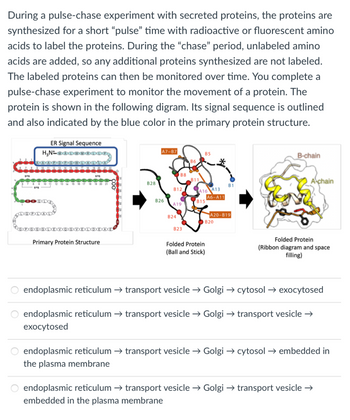
Human Anatomy & Physiology (11th Edition)
11th Edition
ISBN: 9780134580999
Author: Elaine N. Marieb, Katja N. Hoehn
Publisher: PEARSON
expand_more
expand_more
format_list_bulleted
Concept explainers
Question

Transcribed Image Text:During a pulse-chase experiment with secreted proteins, the proteins are
synthesized for a short “pulse” time with radioactive or fluorescent amino
acids to label the proteins. During the “chase" period, unlabeled amino
acids are added, so any additional proteins synthesized are not labeled.
The labeled proteins can then be monitored over time. You complete a
pulse-chase experiment to monitor the movement of a protein. The
protein is shown in the following digram. Its signal sequence is outlined
and also indicated by the blue color in the primary protein structure.
ER Signal Sequence
H₂NDM
U
O
VOGVEXDXDXE
Primary Protein Structure
B28
A7-87
B26
B8
B12
A19
B24
B23
B11
B5
A16 A13
A6-A11
B15
B20
Folded Protein
(Ball and Stick)
B1
A20-B19
B-chain
A chain
Folded Protein
(Ribbon diagram and space
filling)
endoplasmic reticulum → transport vesicle → Golgi → cytosol → exocytosed
endoplasmic reticulum → transport vesicle → Golgi → transport vesicle →
exocytosed
endoplasmic reticulum → transport vesicle → Golgi → cytosol → embedded in
the plasma membrane
endoplasmic reticulum → transport vesicle → Golgi → transport vesicle →
embedded in the plasma membrane
Expert Solution
This question has been solved!
Explore an expertly crafted, step-by-step solution for a thorough understanding of key concepts.
This is a popular solution
Trending nowThis is a popular solution!
Step by stepSolved in 3 steps

Knowledge Booster
Learn more about
Need a deep-dive on the concept behind this application? Look no further. Learn more about this topic, biology and related others by exploring similar questions and additional content below.Similar questions
- You plan to synthesize a peptide to be used as a vaccine to treat melanoma, a particularly aggressive form of skin cancer. Normally, gp100, a protein on the surface of melanocytes, activates cell growth when it is bound by its ligand. Activation of the growth pathway depends on the presence of threonine in the ligand. The effective peptide vaccine will mimic the natural ligand, but won’t cause cell growth and division. Below is the sequence of the natural ligand: LDMKTAG In order to ensure your newly designed peptide vaccine does not cause cell growth upon binding, you must substitute the Threonine residue at position 5. What amino acid would you replace it with, bearing in mind that the peptide should still be similar enough to bind to the gp100 protein in the surface of melanocytes. Explain your choice. Your vaccine will be administered as a topical cream, and you require your peptide to have an overall neutral charge in order to be functional. At what pH should you formulate…arrow_forwardWhich of the following is not a method for determining the high resolution structure of a folded channel protein? Group of answer choices -high resolution electron microscopy -Xray crystallography -site directed mutagenesis -Cryo electron microscopyarrow_forwardRegarding equations in Protein and Ligand binding.arrow_forward
- Fluorescence-activated cell sorting (FACS) is a powerful technique for separating cells according to their content of particular molecules. For example, a fluorescence-labeled antibody specific for a cell-surface protein can be used to detect cells containing such a molecule. Suppose that you want to isolate cells that possess a receptor enabling them to detect bacterial degradation products. However, you do not yet have an antibody directed against this receptor. Which fluorescence-labeled molecule would you prepare to identify such cells?arrow_forwardDefine downstream processing when producing a protein and list two examples. Cite itarrow_forwardWhat do you expect to see in a protein truncation test when there is a nonsense mutation? What do you expect to see in a protein truncation test when there is a nonsense mutation? there will be no signal from the mutated protein the mutated protein will be less abundant (have a weaker signal) that the regular protein the mutated protein will be shorter than the regular protein there will be two bands on the gel for the mutated proteinarrow_forward
arrow_back_ios
arrow_forward_ios
Recommended textbooks for you
 Human Anatomy & Physiology (11th Edition)BiologyISBN:9780134580999Author:Elaine N. Marieb, Katja N. HoehnPublisher:PEARSON
Human Anatomy & Physiology (11th Edition)BiologyISBN:9780134580999Author:Elaine N. Marieb, Katja N. HoehnPublisher:PEARSON Biology 2eBiologyISBN:9781947172517Author:Matthew Douglas, Jung Choi, Mary Ann ClarkPublisher:OpenStax
Biology 2eBiologyISBN:9781947172517Author:Matthew Douglas, Jung Choi, Mary Ann ClarkPublisher:OpenStax Anatomy & PhysiologyBiologyISBN:9781259398629Author:McKinley, Michael P., O'loughlin, Valerie Dean, Bidle, Theresa StouterPublisher:Mcgraw Hill Education,
Anatomy & PhysiologyBiologyISBN:9781259398629Author:McKinley, Michael P., O'loughlin, Valerie Dean, Bidle, Theresa StouterPublisher:Mcgraw Hill Education, Molecular Biology of the Cell (Sixth Edition)BiologyISBN:9780815344322Author:Bruce Alberts, Alexander D. Johnson, Julian Lewis, David Morgan, Martin Raff, Keith Roberts, Peter WalterPublisher:W. W. Norton & Company
Molecular Biology of the Cell (Sixth Edition)BiologyISBN:9780815344322Author:Bruce Alberts, Alexander D. Johnson, Julian Lewis, David Morgan, Martin Raff, Keith Roberts, Peter WalterPublisher:W. W. Norton & Company Laboratory Manual For Human Anatomy & PhysiologyBiologyISBN:9781260159363Author:Martin, Terry R., Prentice-craver, CynthiaPublisher:McGraw-Hill Publishing Co.
Laboratory Manual For Human Anatomy & PhysiologyBiologyISBN:9781260159363Author:Martin, Terry R., Prentice-craver, CynthiaPublisher:McGraw-Hill Publishing Co. Inquiry Into Life (16th Edition)BiologyISBN:9781260231700Author:Sylvia S. Mader, Michael WindelspechtPublisher:McGraw Hill Education
Inquiry Into Life (16th Edition)BiologyISBN:9781260231700Author:Sylvia S. Mader, Michael WindelspechtPublisher:McGraw Hill Education

Human Anatomy & Physiology (11th Edition)
Biology
ISBN:9780134580999
Author:Elaine N. Marieb, Katja N. Hoehn
Publisher:PEARSON

Biology 2e
Biology
ISBN:9781947172517
Author:Matthew Douglas, Jung Choi, Mary Ann Clark
Publisher:OpenStax

Anatomy & Physiology
Biology
ISBN:9781259398629
Author:McKinley, Michael P., O'loughlin, Valerie Dean, Bidle, Theresa Stouter
Publisher:Mcgraw Hill Education,

Molecular Biology of the Cell (Sixth Edition)
Biology
ISBN:9780815344322
Author:Bruce Alberts, Alexander D. Johnson, Julian Lewis, David Morgan, Martin Raff, Keith Roberts, Peter Walter
Publisher:W. W. Norton & Company

Laboratory Manual For Human Anatomy & Physiology
Biology
ISBN:9781260159363
Author:Martin, Terry R., Prentice-craver, Cynthia
Publisher:McGraw-Hill Publishing Co.

Inquiry Into Life (16th Edition)
Biology
ISBN:9781260231700
Author:Sylvia S. Mader, Michael Windelspecht
Publisher:McGraw Hill Education